AP Exam Study Guide
1/33
There's no tags or description
Looks like no tags are added yet.
Name | Mastery | Learn | Test | Matching | Spaced |
|---|
No study sessions yet.
34 Terms
What is the difference between a biotic and an abiotic factor?
Biotic factors are living components of an ecosystem, such as plants, animals, and microorganisms, while abiotic factors are non-living elements, including water, sunlight, soil, and temperature. Understanding these differences is crucial for studying ecological interactions.
How do abiotic and biotic factors influence one another?
Abiotic factors influence biotic factors by affecting the habitat and resources available to living organisms, while biotic factors can modify abiotic factors, such as vegetation affecting soil quality and moisture levels.
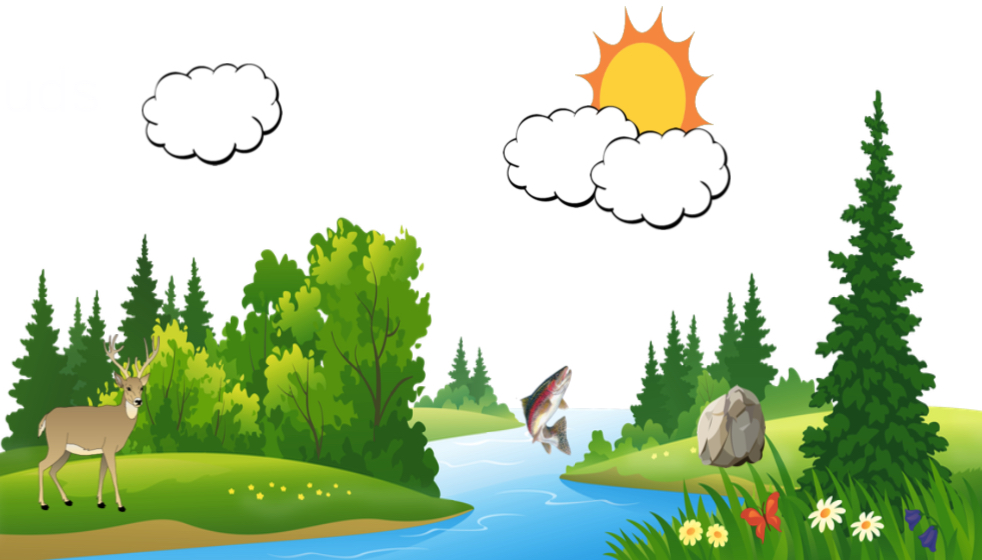
Classify the items in the picture as abiotic or biotic.
Biotic = any of the animals and plants
Abiotic = water, soil, sunlight, temperature, clouds
How are the terms genetic diversity, species diversity, and ecological diversity different from one another?
Genetic diversity: measures the genetic variation among individuals in a population
Species diversity: refers to the number of species in a particular type of habitat
Ecological diversity: measures the diversity of ecosystems or habitats that exist in a given region
What is meant by the terms ecological niche and range of tolerance?
Ecological niche: an organism’s role and position within its environment
Range of tolerance: encompasses the limits to the abiotic conditions that a species can tolerate
What does the ecological niche include?
How it meets its needs for food and shelter
How it survives
How it reproduces
All of its interactions with the biotic and abiotic factors of its environment
What is the difference between an organism’s realized niche and fundamental niche?
Realized niche: the range of abiotic/biotic conditions under which a species actually lives
Fundamental niche: all of the abiotic environmental conditions that a species would potentially thrive
Which type of species (generalist or specialist) would have a broad niche and which would have a narrow niche? Why?
Generalist = Broader
Specialist = Narrower
Generalist species are capable of living under a wider range of abiotic and/or biotic conditions compared to a specialist.
How would the range of tolerance differ for these types of species?
Generalists have a wider range of tolerance for environmental conditions, while specialists have a narrower range adapted to specific conditions.
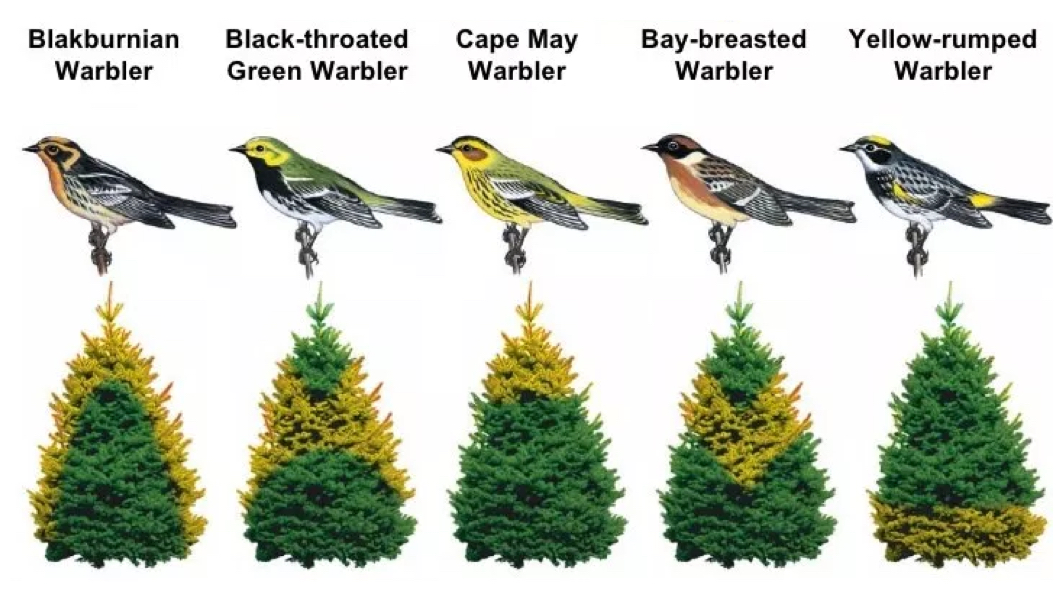
How is this picture a representative of both resource partitioning and
the competitive exclusion principle (CEP)?
Resource partitioning refers to the way species divide resources to minimize competition for survival, while the competitive exclusion principle states that two species competing for the same resources cannot coexist if other ecological factors are constant.
Define these types of symbiosis:
Mutualism
Commensalism
Parasitism
Mutualism is a symbiotic relationship where both species benefit; commensalism is where one species benefits and the other is neither helped nor harmed; parasitism occurs when one species benefits at the expense of the other.
What role does a keystone species play within an ecosystem? Provide an
example of a keystone species to use in your explanation.
A keystone species is one that has a disproportionate effect on its ecosystem, often maintaining the structure and biodiversity of the community. An example is the sea otter, which preys on sea urchins to prevent overgrazing of kelp forests.
Differentiate between a native, non-native, and invasive species; how do
each influence an ecosystem?
A native species is one that occurs naturally in a specific ecosystem; a non-native species is introduced to an ecosystem where it does not naturally occur; an invasive species is a non-native species that spreads rapidly, often disrupting the ecosystem by outcompeting native species.
What is the connection between species richness and ecosystem services?
Where would you expect species richness be greatest?
Species richness, the number of different species in an area, is generally positively correlated with ecosystem services. More diverse ecosystems tend to offer more and more resilient services. Species richness is expected to be highest in tropical rainforests, coral reefs, and ocean bottom zones due to stable climates, abundant resources, and complex structures that support a wide range of life.
Define these types of population dispersion.
Uniform
Random
Clumped
Uniform: individuals within a population are spaced evenly throughout their habitat
Random: a situation where individuals in a population are distributed throughout an area in a way that is independent of other individuals' locations
Clumped: a population distribution pattern where individuals are grouped together in clusters or patches within a larger area
What are the different seral stages of succession that occur for a temperate deciduous forest? Be able to describe each. (Hint: What is a sere?)
Temperate deciduous forest: a biome characterized by broadleaf trees that lose their leaves seasonally, typically in the fall, and experience four distinct seasons: winter, spring, summer, and autumn
Sere: the entire sequence of communities that successively change in a given area
Early Seral (Pioneer) Stage: Characterized by grasses and herbaceous plants like horseweed, crabgrass, and pigweed
Mid Seral Stage: Shrub and sapling communities begin to develop, with species like broomsedge grass, and young trees starting to appear.
Late Seral Stage: A mix of mature trees, including both shade-intolerant (like lines) and shade-tolerant (like hardwoods) species.
Climax Stage (Late Seral/Old-Growth): A stable, mature forest dominated by long-lived, shade-tolerant tree species like oak and hickory.
What is primary succession and what is secondary succession?
Primary Succession: occurs in a previously uninhabited environment, like bare rock, where soil needs to be created before plants can grow
Secondary succession: happens in an area that was previously inhabited by life but has been disturbed, with soil already present
What is a pioneer species? What are some examples?
Pioneer species: First organism to colonize a barren or disturbed environment, initiating ecological succession
Examples: Lichens, mosses, and some types of bacteria
What is the difference between succession and zonation?
Succession: the gradual process of change in plant/animal communities in an area over time
Zonation: the distinct banding or arrangement of species and communities across an area, typically due to changes in environmental conditions like altitude, or tidal level
How are food chains and food webs connected? How are they related to the flow of matter and energy in a system. How do matter and energy both move through a system from trophic level to trophic level?
Food webs include all of the food chains in a given ecosystem, and they both illustrate how energy can be passed from one organism to the next (following the 10% rule).
While energy only moves though a food chain/web in one direction, matter flows cyclically as organisms are concussed, digested, and decomposed OR they release waste to the system.
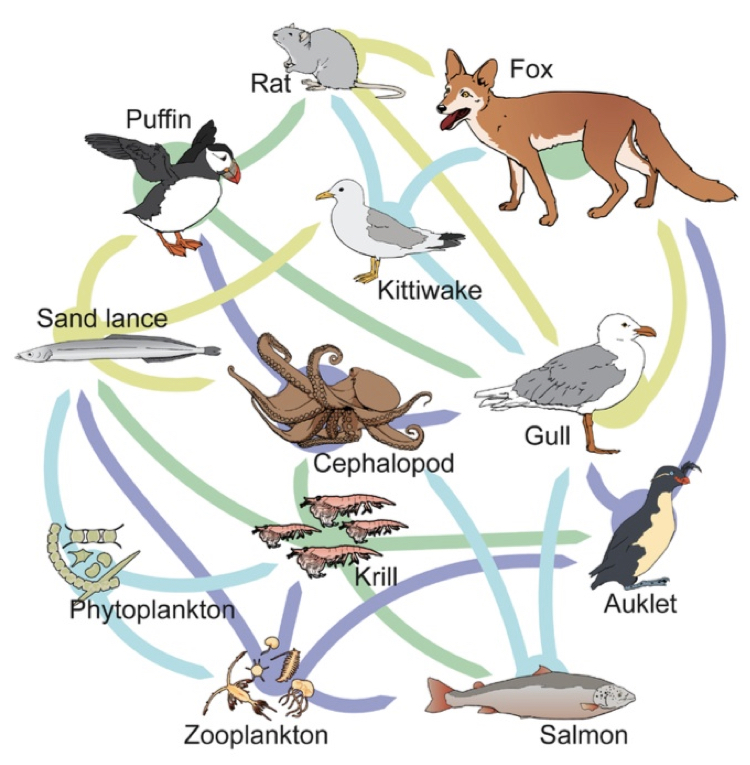
Identify the following in the food web pictured below:
Producer
Carnivore
Omnivore
Scavenger
Herbivore
Primary consumer
Secondary consumer
Tertiary consumer
What two things are missing from this food web?
Producer: phytoplankton
Carnivore: Puffin, gull
Omnivore: Krill, sand lance
Scavenger: Rat (most likely)
Herbivore: Zooplankton
Primary consumer: Krill, sand lance, zooplankton
Secondary consumer: Salmon, auklet, sand lance
Tertiary consumer: Rat, fox, gull, cephalopod
The sun and decomposers are missing from this food web.
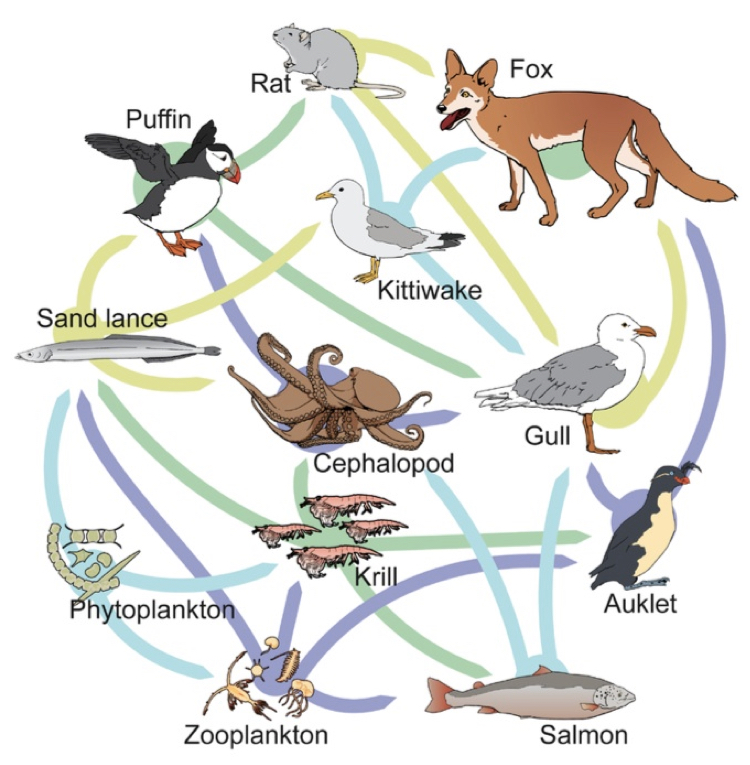
If the phytoplankton have 5,926 Joules of energy, how much energy would the kittiwake have at its disposal?
5,926 Joules x .10 x .10 = 59.26 Joules
Phytoplankton ➡ Sand lance ➡ Kittiwake
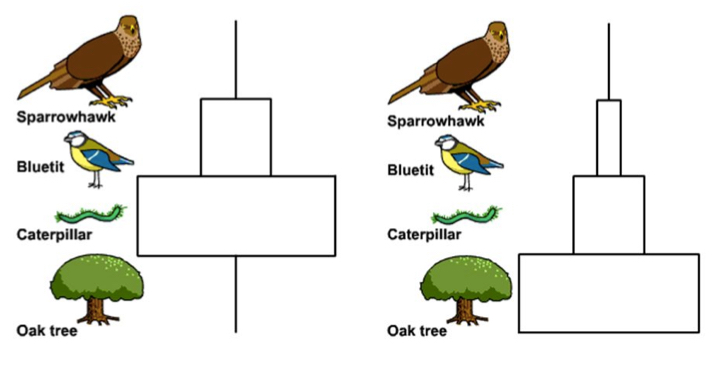
Which image represents a pyramid of numbers and which presents a pyramid of biomass?
Numbers = Left
Biomass = Right
How do carbon and oxygen cycle in an ecosystem?
Photosynthesis: Plants absorb carbon dioxide from the atmosphere and convert it into organic molecules (like sugars) during photosynthesis, also releasing oxygen as a byproduct.
Cellular respiration: Organisms, including animals, use oxygen to break down organic matter (like sugars) during cellular respiration, producing energy and releasing carbon dioxide as a waste product.
Fossil Fuels: Over long periods, organic matter can be buried and converted into fossil fuels (like coal, oil, and natural gas). Burning these fossil fuels releases the stored carbon back into the atmosphere.
Oceanic Exchange: Oceans play a significant role in the carbon cycle by absorbing and releasing carbon dioxide from the atmosphere, and they are also a major sink for carbon.
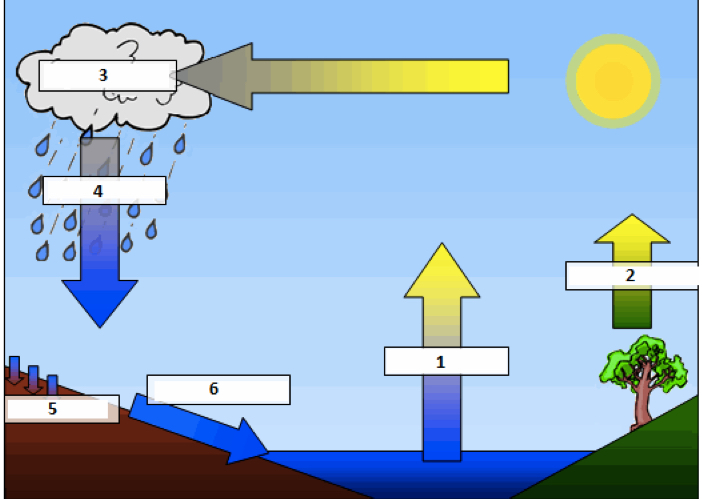
Identify each part of the water cycle. Which steps represent storages and which flows?
1 = Evaporation
2 = Transpiration: the process where plants release water vapor into the atmosphere, primarily through tiny pores called stomata on their leaves
3 = Condensation: the process where water vapor in the air turns into liquid water, often forming droplets or clouds
4 = Precipitation
5 = Infiltration
6 = Runoff
They are all flows except for #3. Water can also be stored in large bodies of water (#1), the ground (#5), and in organisms (the tree).
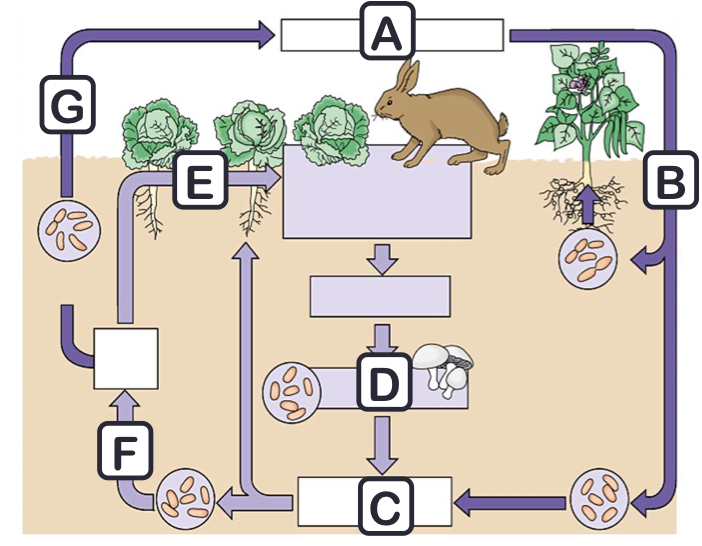
Identify each part of the nitrogen cycle. Which steps represent storages and which flows?
A = Atmospheric nitrogen (storage in air)
B = Nitrogen fixation (flow): the biological process where atmospheric nitrogen gas (N2) is converted into forms like ammonia or nitrates (NO3)
C = Ammonia (storage in soil): (NH3); a colorless gas with a pungent odor, and a key component of the nitrogen cycle
D = Decomposition (flow): the natural process by which dead organic matter is broken down into simpler substances
E = Assimilation (Storage in organisms): the process by which plants and animals incorporate nitrogen-containing compounds, like nitrates and ammonia, into their tissues
F = Nitrification (flow): the biological process where bacteria convert ammonia (NH3) or ammonium (NH4+) to nitrite (NO2-) and then to nitrate (NO3-)
G = Denitrification (flow): the process where bacteria convert nitrate (NO3-) into gaseous nitrogen (N2) under anaerobic conditions, essentially returning nitrogen to the atmosphere
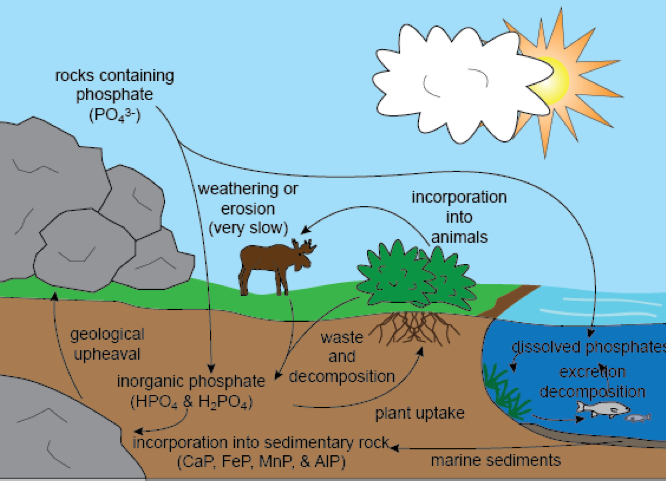
Where would phosphorus be stored and where it flows? (Storage = red circles; flows = yellow arrows)
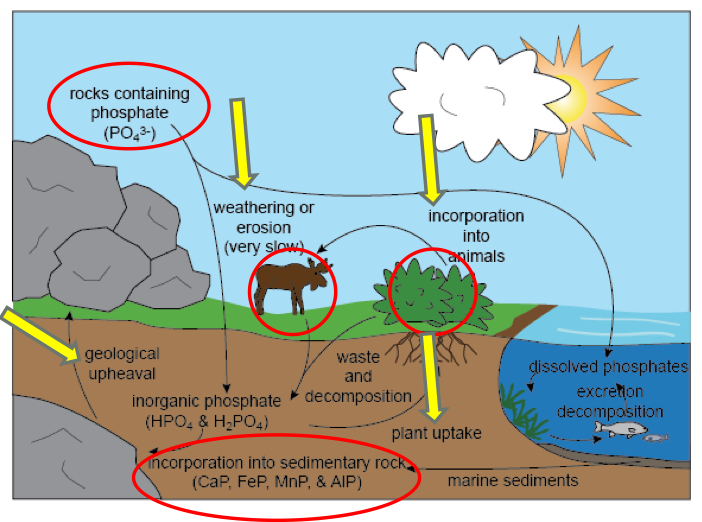
What is the difference between the 1st Law of Thermodynamics and the 2nd Law of Thermodynamics and how do they impact ecosystems?
1st Law: energy cannot be created or destroyed, only transformed
2nd Law: in every energy transformation, some energy is lost as unusable energy, like heat, leading to an increase in entropy (disorder)
In ecosystems, the 1st Law governs the flow of energy through trophic levels, while the 2nd Law explains why energy is progressively lost at each level.
How is the Earth both an open and closed system?
It’s an open system for energy, as it receives and radiates energy from the sun and space.
It’s a closed system for matter, meaning while matter within the Earth system (e.g., the water cycle), very little matter Exeter’s or leaves the Earth from or to the rest of the universe.
What is an isolated system and what is an example?
One where no energy or matter is exchanged (ex = sealed terrarium)
What are the similarity and differences between the ecological pyramids of energy, numbers, and biomass?
Energy pyramids: energy flow
Biomass pyramids: total mass of organisms
Pyramids of numbers: the number of organisms at each level
Think about the various types of freshwater – streams/rivers, ponds/lakes, and wetlands: Compare and contrast the following�� oxygen levels, dilution rates, and organism adaptations (plants and animals).
Streams/Rivers
O2 Levels: High
Dilution Rates: High
Plant Adaptations: Grow on rocks or near shores
Animal Adaptations: Appendages able to cling to rocks; use rocks for microhabitat
Ponds/Lakes
O2 Levels: Low
Dilution Rates: Low
Plant Adaptations: Float on surface; found near shores
Animal Adaptations: Tolerant of low O2 levels; use area for breeding grounds
Wetlands
O2 Levels: O2
Dilution Rates: Varies
Plant Adaptations: Able to handle fluctuating water levels
Animal Adaptations: Migratory stop; nursery and breeding area
How/why are wetland ecosystems important? What ecosystem services do they provide?
Water purification: removes excess nutrients like nitrates and phosphorus
Flood control: can absorb excess water
Habitat for biodiversity: serve as breeding grounds, feeding areas, and migration corridors for many animals, including birds, fish, and other wildlife
Carbon storage: carbon sinks; absorbing and storing large amounts of atmospheric carbon dioxide
Identify several ways human activities many positively or negatively impact the health of a freshwater ecosystem.
Positive
Restoration Projects: Rehabilitating degraded habitats
Conservation projects: Protecting natural areas, implementing sustainable fishing practices, and reducing pollution
Responsible water management: efficient irrigation techniques, water-wise landscaping
Regulation and policy
Negative
Pollution: Industrial and agricultural runoff, sewage, and other pollutants
Habitat destruction: dams, channelization, and urbanization can alter river flow, reduce habitat and fragment ecosystems
Overexploitation: excessive fishing and water extraction can deplete fish populations and reduce water availability
Invasive species: introduction of non-native species can outcompete native species, disrupt food webs, and negatively impact ecosystem structure
Climate change